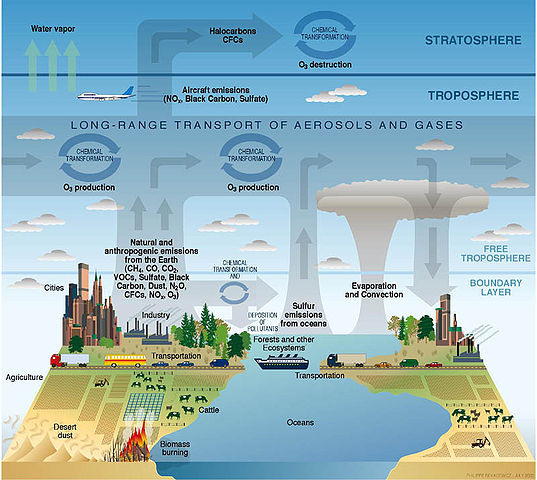User:Milton Beychok/Sandbox

The evolution and/or cycles of various elements in Earth's atmosphere.[1]
Atmospheric science is the umbrella term for the study of the atmosphere — the blanket of air covering the Earth.
It is a relatively new discipline that is concerned with the composition, structure and evolution of the atmosphere as well as its processes and how those processes interrelate with other systems.[2][3][4]
The adjacent image depicts the various processes occurring in the atmosphere and how they relate to other Earth systems such as agriculture, land, sea and air transportation, other ecosystems, air pollutant emissions, the water cycle (evaporation and rainfall), forests and forest fires, deserts and desert dust, industry, etc.
To the extent that atmospheric science focuses primarily on the Earth's atmosphere, it can be regarded as a subfield of the Earth sciences, each of which is a particular synthesis of the fundamentals of physics, chemistry, fluid dynamics and thermodynamics.
What atmospheric science includes
Atmospheric science includes a number of primary subdisciplines as briefly discussed further in this section.[5]
Meteorology
Meteorology is the study of atmospheric chemistry, atmospheric physics and weather forecasting. As of 2011, about 34 percent of atmospheric scientists in the United States are employed by the U.S. federal government, mostly in the National Weather Service. Most of the other atmospheric scientists are working as researchers in the various subdisciplines of atmospheric science. [4]
Climatology
Climatology is the study of long and short-term climate trends (or changes) due to natural and anthropogenic causes.
Hydrology
Hydrology is the study of the movement, characteristics and distribution of seawater, surface-water, groundwater and water quality.
Oceanography
Oceanography is the study of the oceans.
Air Pollution
Air pollution includes the chemicals and particulate matter introduced into the atmosphere that cause harm or discomfort to humans or other living organisms, or damage the environment.
Aeronomy
Aeronomy is the study of the upper layer's of Earth's atmosphere
Planetary science
Planetary science is the study of planets, moons, and planetary systems, in particular those of the Solar System and how they were created.
As of 2011, about 34 percent of atmospheric scientists in the United States are employed by the U.S. federal government, mostly in the National Weather Service.[4]
References
- ↑ The 2003 Strategic Plan for the U.S. Climate Change Science Program (CCSP). Figure 3-1, created by Philippe Rekacewicz.
- ↑ Peter V. Hobbs and John M. Wallace (2006). Atmospheric Science: An Introductory Survey, 2nd Edition. Academic Press. ISBN 0-12-732951-X.
- ↑ A. Chandrasekar (2010). Basics of Atmospheric Science. PHI Learning. ISBN 8120340221.
- ↑ 4.0 4.1 4.2 Bureau of Labor Statistics: Occupational Outlook Handbook, 2010-11 Edition: Atmospheric Scientists
- ↑ Duscovering the Atmospheric Sciences, From the website of the University Corporation for Atmospheric Research (UCAR)